In Situ Tensile Deformation and Mechanical Properties of α Platelets TC21 Alloy
Abstract
:1. Introduction
2. Materials and Methods
3. Results and Discussion
3.1. Microstructure
3.2. Mechanical Properties
3.3. In Situtensile Deformation
3.4. Fracture Morphology
3.5. Discussion
3.5.1. Key Microstructure Feature Affecting Mechanical Properties
3.5.2. Crack Initiation and Propagation
3.5.3. Deformation and Fracture Mechanism of TC21 Alloy with α Platelets
4. Conclusions
- (1)
- With the increase in the cooling rate, the thickness of the α platelet, α cluster, GB α, and α+β platelet decrease, and the strength of the alloy increases while the plasticity decreases. The thickness of the α+β platelet is the main characteristic factor affecting the mechanical properties.
- (2)
- The zigzag path indicating the continuous deflection of cracks appears when the cracks encounter thick α platelet and wide α colonies with different orientations. However, a smooth crack path can be seen in the specimen with thin α platelets and narrow α colonies, because the cracks can easily propagate through thin α platelets and narrow α colonies with a disordered orientation.
- (3)
- The slip and shear are the primary deformation modes and the ductile and cleavage fractures present the primary fracture mechanism of the specimens with α platelets. However, a large number of large dimples appear on the fractures of the specimen with thick α platelets, indicating a dominating ductile fracture mode.
Author Contributions
Funding
Institutional Review Board Statement
Informed Consent Statement
Data Availability Statement
Conflicts of Interest
References
- Wen, X.; Wan, M.P.; Huang, C.W.; Lei, M. Strength and fracture toughness of TC21 alloy with multi-level lamellar microstructure. Mater. Sci. Eng. A 2019, 740, 121–129. [Google Scholar] [CrossRef]
- Lin, Y.C.; Huang, J.; He, D.G.; Zhang, X.Y.; Wu, Q.; Wang, L.H.; Chen, C.; Zhou, K.C. Phase transformation and dynamic recrystallization behaviors in a Ti55511 titanium alloy during hot compression. J. Alloys Compd. 2019, 795, 471–482. [Google Scholar] [CrossRef]
- Banerjee, D.; Williams, J.C. Perspectives on Titanium Science and Technology. Acta Mater. 2013, 61, 844–879. [Google Scholar] [CrossRef]
- Cai, J.; Guo, M.; Peng, P.; Han, P.; Yang, X.K.; Ding, B.; Qiao, K.; Wang, K.S.; Wang, W. Research on Hot Deformation Behavior of As-Forged TC17 Titanium Alloy. J. Mater. Eng. Perform. 2021, 30, 7259–7274. [Google Scholar] [CrossRef]
- Pang, G.D.; Lin, Y.C.; Jiang, Y.Q.; Zhang, X.Y.; Liu, X.G.; Xiao, Y.W.; Zhou, K.C. Precipitation behaviors and orientation evolution mechanisms of α phases in Ti-55511 titanium alloy during heat treatment and subsequent hot deformation. Mater. Charact. 2020, 167, 110471. [Google Scholar] [CrossRef]
- Jiang, Y.Q.; Lin, Y.C.; Wang, G.Q.; Pang, G.D.; Chen, M.S.; Huang, Z.C. Microstructure evolution and a unified constitutive model for a Ti-55511 alloy deformed in β region. J. Alloy. Compd. 2021, 870, 159543. [Google Scholar] [CrossRef]
- Zhang, S.; Liang, Y.L.; Xia, Q.F.; Ou, M.G. Study on tensile deformation behavior of TC21 titanium alloy. J. Mater. Eng. Perform. 2019, 28, 1581–1590. [Google Scholar] [CrossRef]
- Lin, Y.C.; Xiao, Y.W.; Jiang, Y.Q.; Pang, G.D.; Li, H.B.; Zhang, X.Y.; Zhou, K.C. Spheroidization and dynamic recrystallization mechanisms of ti-55511 alloy with bimodal microstructures during hot compression in α+β region. Mater. Sci. Eng. A 2020, 782, 139282. [Google Scholar] [CrossRef]
- Filip, R.; Kubiak, K.; Ziaja, W.; Sieniawski, J. The effect of microstructure on the mechanical properties of two-phase titanium alloys. J. Mater. Process. Technol. 2003, 133, 84–89. [Google Scholar] [CrossRef]
- He, S.; Zeng, W.; Xu, J.; Chen, W. The effects of microstructure evolution on the fracture toughness of BT-25 titanium alloy during isothermal forging and subsequent heat treatment. Mater. Sci. Eng. A 2019, 745, 203–211. [Google Scholar] [CrossRef]
- Yadav, P.; Saxena, K.K. Effect of heat-treatment on microstructure and mechanical properties of Ti alloys: An overview. Mater. Today Proc. 2020, 26, 2546–2557. [Google Scholar] [CrossRef]
- Tan, C.S.; Sun, Q.Y.; Xiao, L.; Zhao, Y.Q.; Sun, J. Characterization of deformation in primary α phase and crack initiation and propagation of TC21 alloy using in-situ SEM experiments. Mater. Sci. Eng. A 2018, 725, 33–42. [Google Scholar] [CrossRef]
- Xia, Q.F.; Liang, Y.L.; Yang, C.L.; Zhang, S.; Ou, M.G. Tensile Deformation Behavior of TC4 Titanium Alloy. Rare Met 2019, 43, 765–773. [Google Scholar]
- Shao, H.; Zhao, Y.Q.; Ge, P.P.; Zeng, W.D. Crack initiation and mechanical properties of TC21 titanium alloy with equiaxed microstructure. Mater. Sci. Eng. A 2013, 586, 215–222. [Google Scholar] [CrossRef]
- Shao, H.; Shan, D.; Zhao, Y.Q.; Ge, P.; Zeng, W.D. Accordance between fracture toughness and strength difference in TC21 titanium alloy with equiaxed microstructure. Mater. Sci. Eng. A 2016, 664, 10–16. [Google Scholar] [CrossRef]
- Castany, P.; Pettinari-Sturmel, F.; Douin, J.; Coujou, A. In situ transmission electron microscopy deformation of the titanium alloy Ti–6Al–4V: Interface behavior. Mater. Sci. Eng. A 2008, 483, 719–722. [Google Scholar] [CrossRef]
- Suri, S.; Viswanathan, G.; Neeraj, T.; Hou, D.H.; Mills, M. Room temperature deformation and mechanisms of slip transmission in oriented single-colony crystals of an α-β titanium alloy. Acta Mater. 1999, 47, 1019–1034. [Google Scholar] [CrossRef]
- Semiatin, S.L.; Bieler, T.R. The effect of alpha platelet thickness on plastic flow during hot working of Ti-6Al-4V with a transformed microstructure. Acta Mater. 2001, 49, 3565–3573. [Google Scholar] [CrossRef]
- Ou, M.G.; Xia, Q.F.; Song, H.C.; Liang, Y.L. Effect of Different Cooling Rates on Microstructure and Mechanical Properties of TC4 Alloy. Rare Met. Mater. Eng. 2019, 48, 638–643. [Google Scholar]
- Ohmori, Y.; Nakai, K.; Ohtsubo, H.; Tusnofuri, M. Formation of Widmanstatten alpha structure in a Ti-6Al-4V alloy. Mater. Trans. JIM 1994, 35, 238–246. [Google Scholar] [CrossRef] [Green Version]
- Furuhara, S.; Takagi, S.; Watanabe, H.; Maki, T. Crystallography of grain boundary α precipitates in a β titanium alloy. Met. Mater. Trans. A 1996, 27, 1635–1646. [Google Scholar] [CrossRef]
- Chen, X.; Yang, X.W. Phase Transformation in TC6 Titanium Alloy during Heating and Cooling. Rare Met. Mater. Eng. 2012, 41, 2123–2126. [Google Scholar]
- Chang, H.; Zhou, L.; Zhang, T.J. Review of Solid Phase Transformation in Titanium Alloys. Rare Met. Mater. Eng. 2007, 36, 1505–1510. [Google Scholar]
- Naydenkin, E.V.; Ratochka, I.V.; Lykova, O.N.; Mishin, I.P. Evolution of the structural phase state, deformation behavior, and fracture of ultrafine-grained near-β titanium alloy after annealing. J. Mater. Sci. 2020, 55, 9237–9244. [Google Scholar] [CrossRef]
- Lai, M.J.; Tasan, C.C.; Raabe, D. Deformation mechanism of ω-enriched Ti-Nb-based gum metal: Dislocation channeling and deformation induced ω-β transformation. Acta Mater. 2015, 100, 290–300. [Google Scholar] [CrossRef]
- Hlaváěek, I.; Chleboun, J.; Babuška, I. Hencky’s and Deformation Theories of Plasticity-Chapter VIII. In Applied Mathematics and Mechanics; North-Holland Series; Elsevier: Amsterdam, The Netherlands, 2004; pp. 241–279. [Google Scholar]
- Zhang, S.F.; Zeng, W.D.; Zhao, Q.Y.; Ge, L.L.; Zhang, M. In situ SEM study of tensile deformation of a near-β titanium alloy. Mater. Sci. Eng. A 2017, 708, 574–581. [Google Scholar] [CrossRef]
- Shan, D.; He, X.Y.; Wang, R.; Fang, C.Q. In-situ study of crack initiation and propagation of lamellar microstructure in TC21 titanium alloy. Ordnance Mater. Sci. Eng. 2015, 38, 20–22. [Google Scholar]
- Chan, K.S. Roles of microstructure in fatigue crack initiation. Int. J. Fatigue 2010, 32, 1428–1477. [Google Scholar] [CrossRef]
- Hook, R.E.; Hirth, J.P. The deformation behavior of isoaxialbicrystals of Fe-3%Si. Acta Metall. 1967, 15, 535–551. [Google Scholar] [CrossRef]
- Holden, F.C.; Ogden, H.R.; Jaffee, R.I. Heat treatment, structure, and mechanical properties of Ti-Mn alloys. JOM 1954, 6, 169–184. [Google Scholar] [CrossRef]
- Shi, R.; Li, G.J.; Nie, Z.H.; Fan, Q.B. Determination of the single-phase constitutive relations of α/β dual phase TC6 titanium alloy. Mater. Sci. Eng. A 2016, 675, 138–146. [Google Scholar] [CrossRef] [Green Version]
- Ankem, S.; Margolin, H. The role of elastic interaction stresses on the onset of plastic flow for oriented two ductile phase structures. Met. Mater. Trans. A 1980, 11, 963–972. [Google Scholar] [CrossRef]
- Fan, J.K.; Li, J.S.; Kou, H.C.; Hua, K.; Tang, B. The interrelationship of fracture toughness and microstructure in a new near β titanium alloy Ti-7Mo-3Nb-3Cr-3Al. Mater. Charact. 2014, 96, 93–99. [Google Scholar] [CrossRef]
- Hook, R.E.; Hirth, J.P. The deformation behavior of non-isoaxialbicrystals of Fe-3%Si. Acta Metall. 1967, 15, 1099–1110. [Google Scholar] [CrossRef]
- Guo, P.; Zhao, Y.Q.; Zeng, W.D.; Hong, Q. The effect of microstructure on the mechanical properties of TC4-DT titanium alloys. Mater. Sci. Eng. A 2013, 563, 106–111. [Google Scholar] [CrossRef]
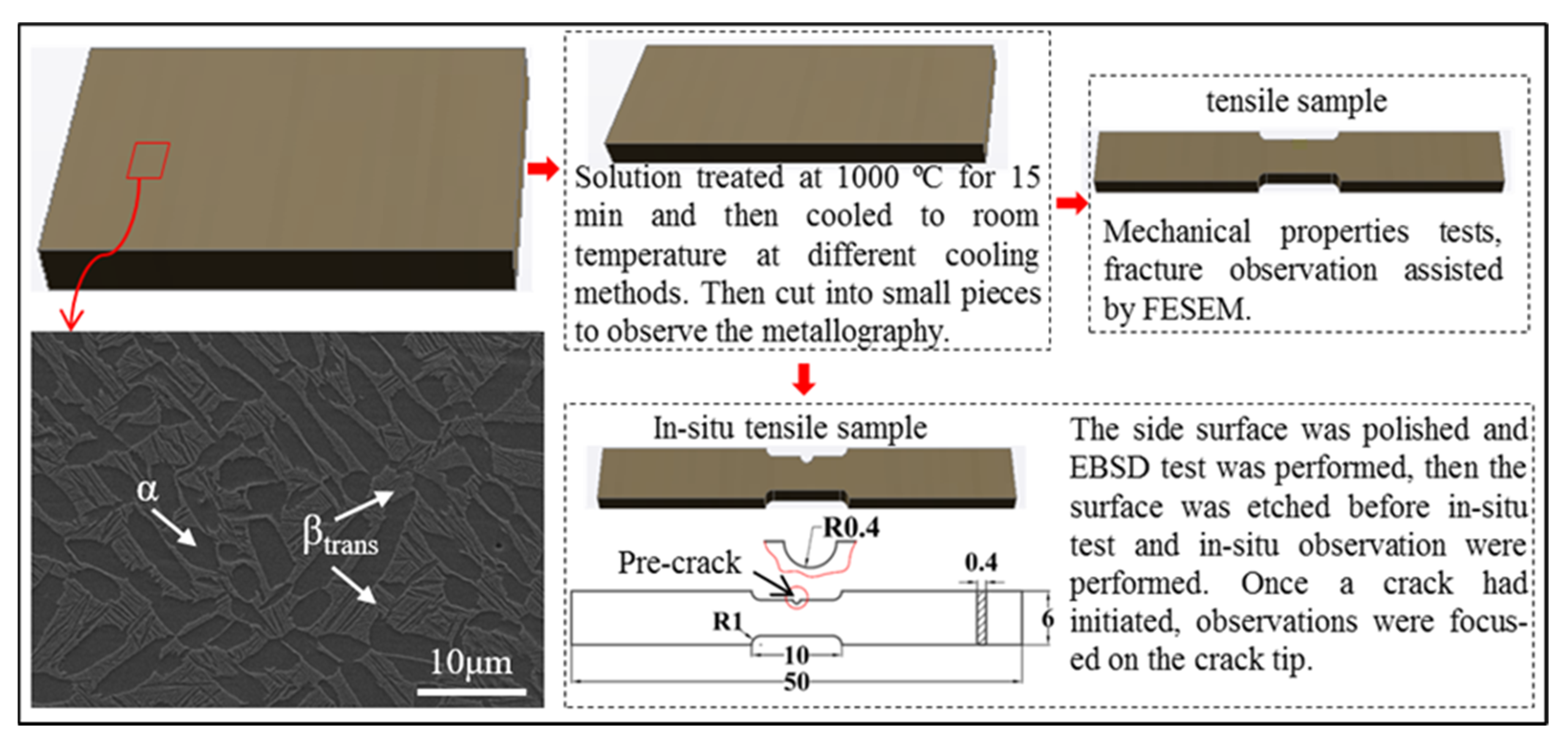

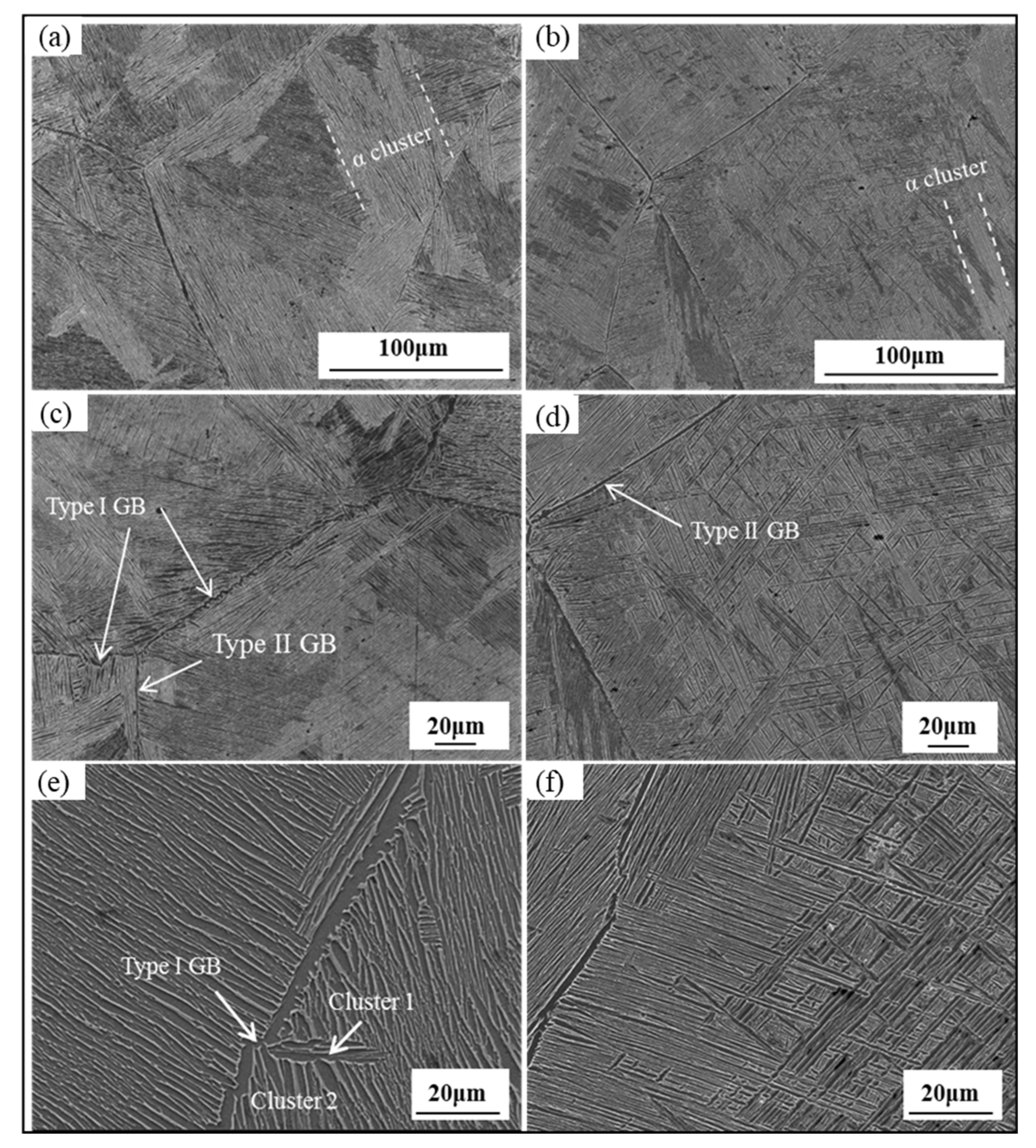
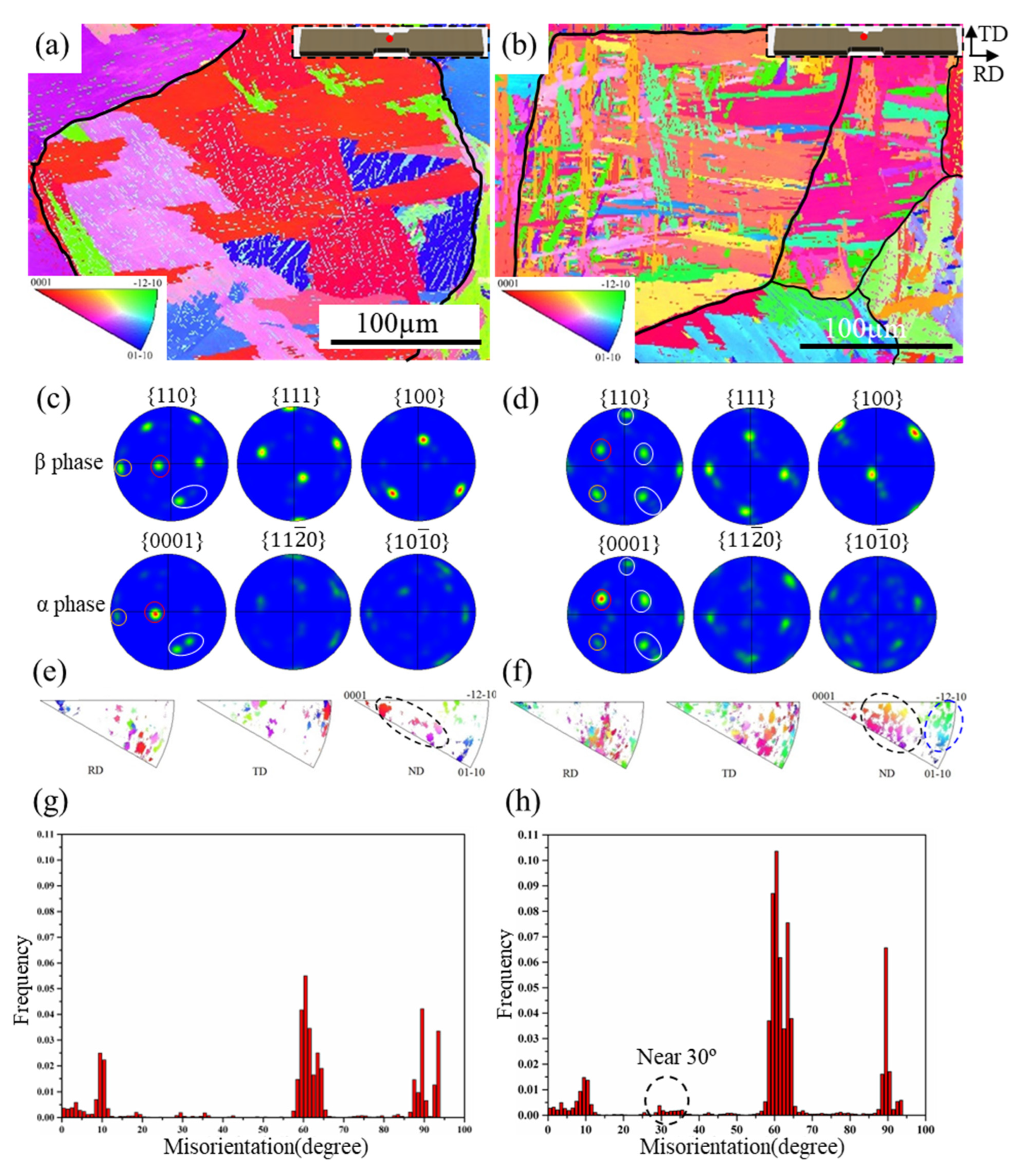
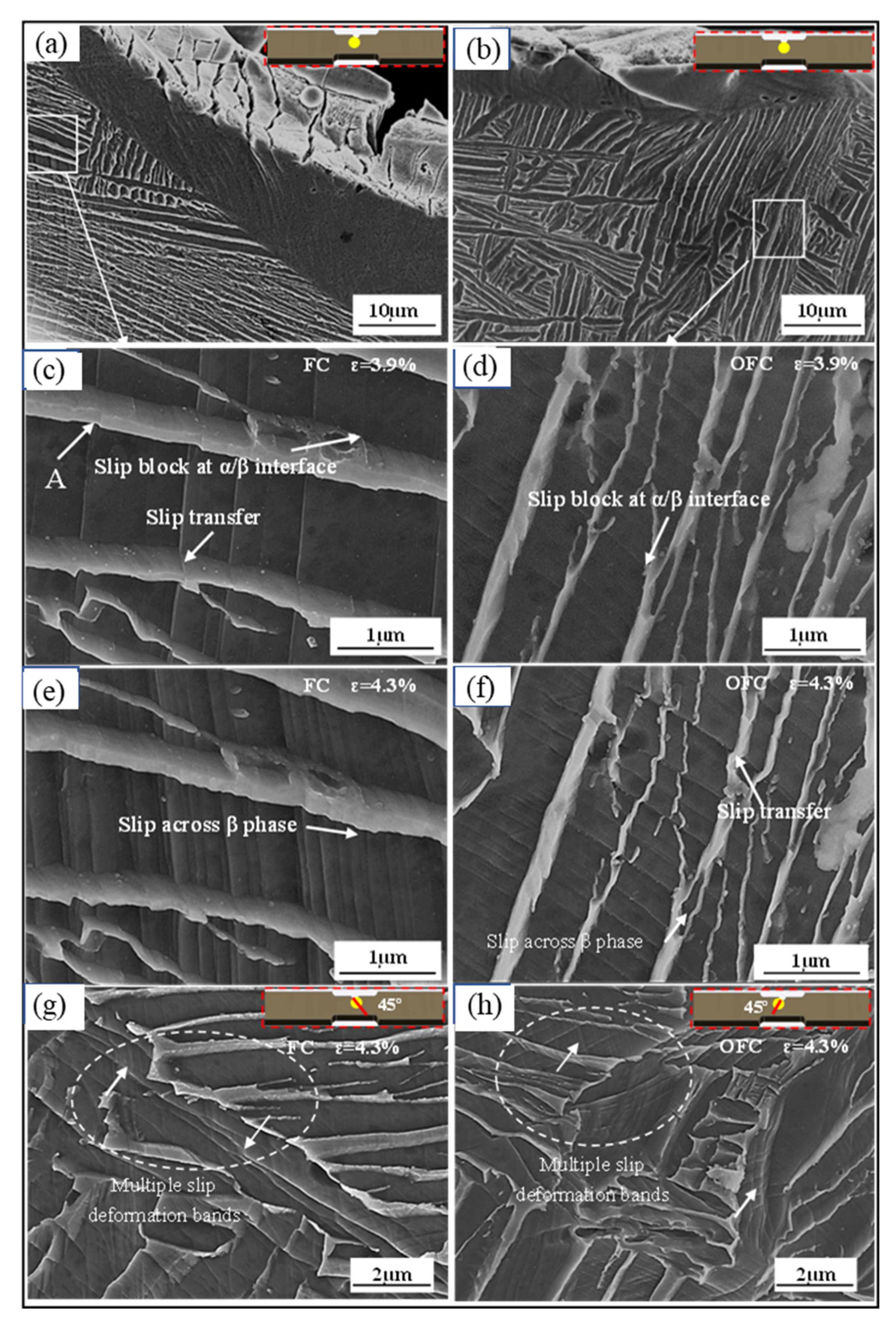
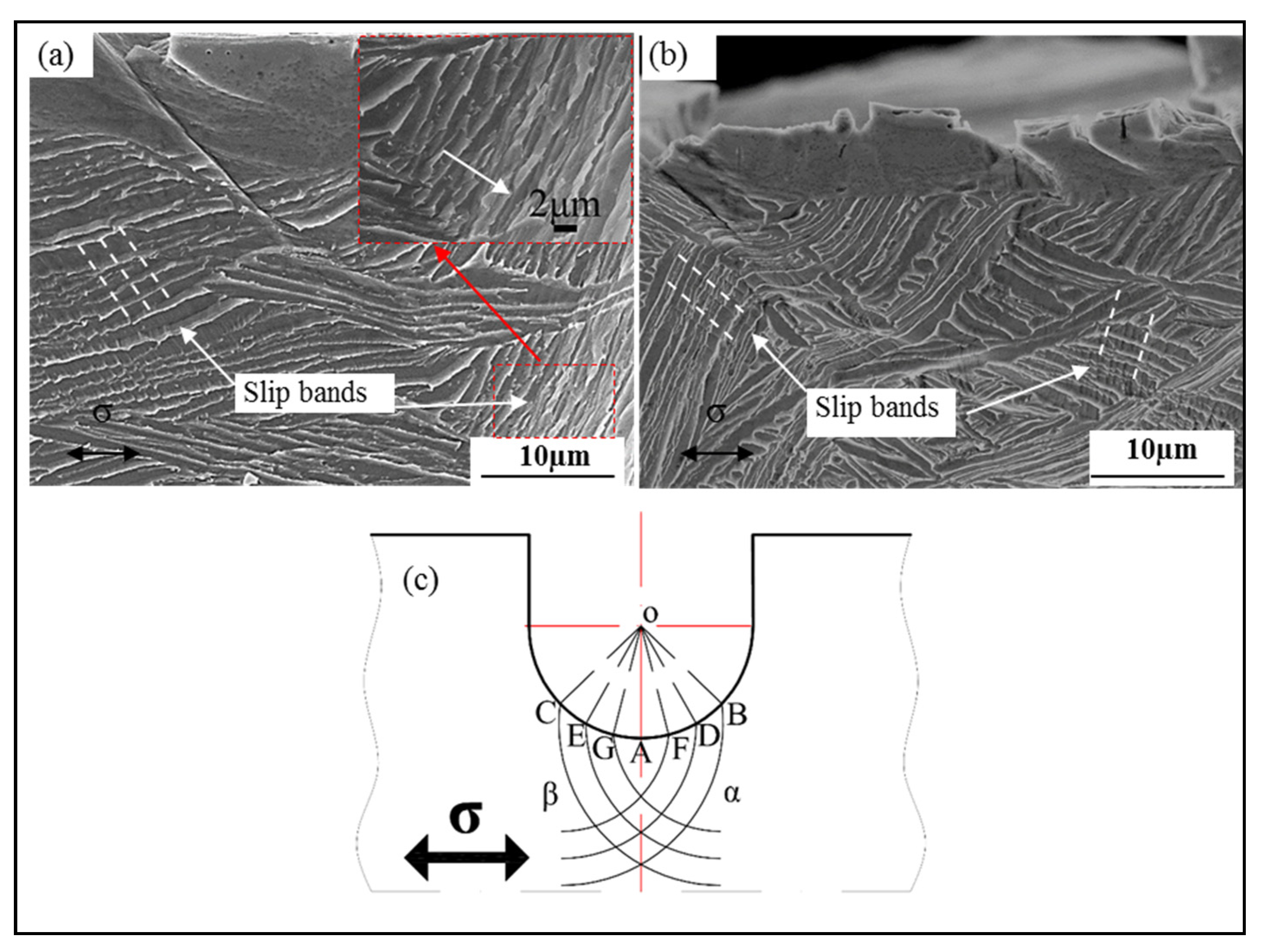
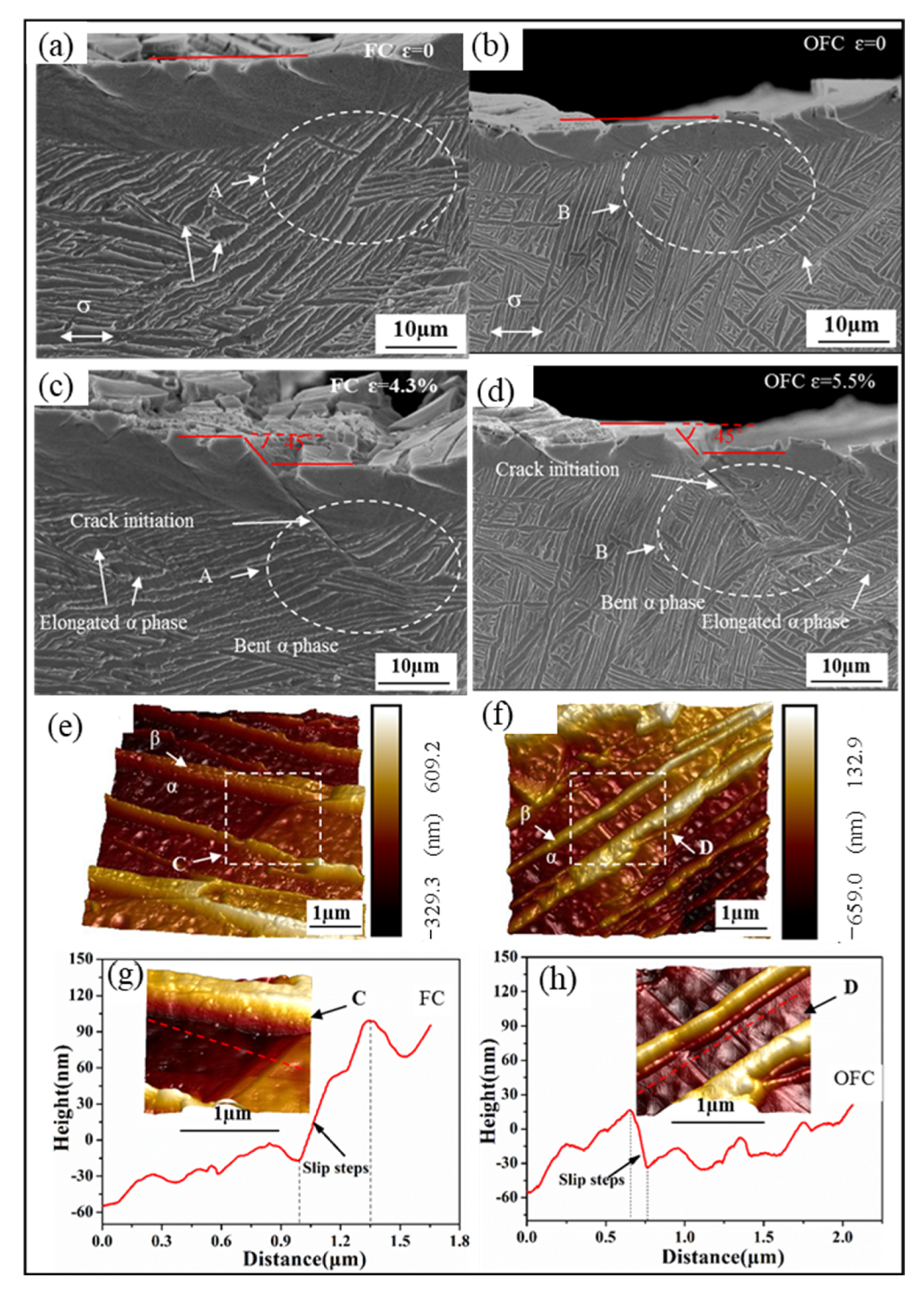
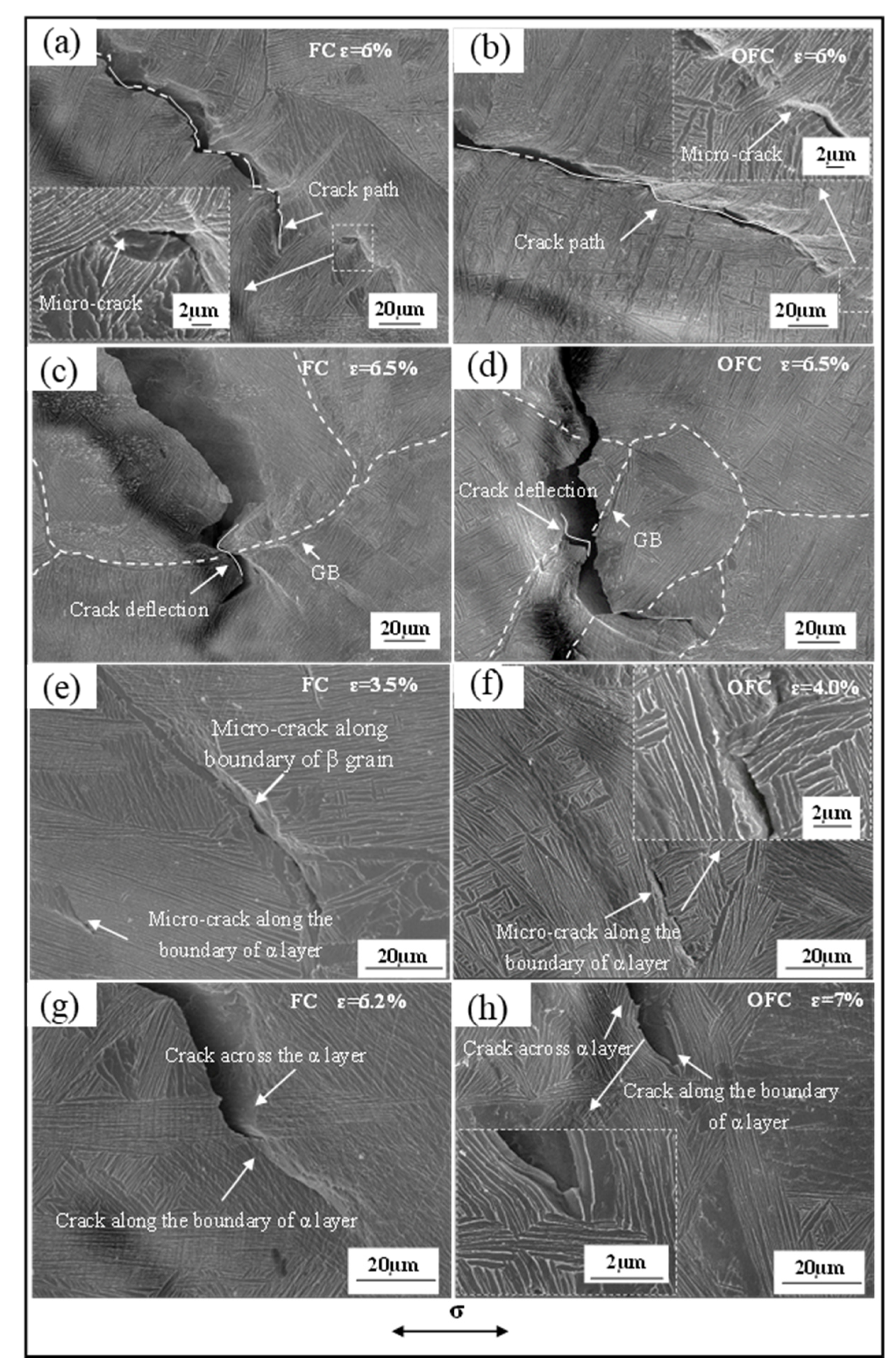


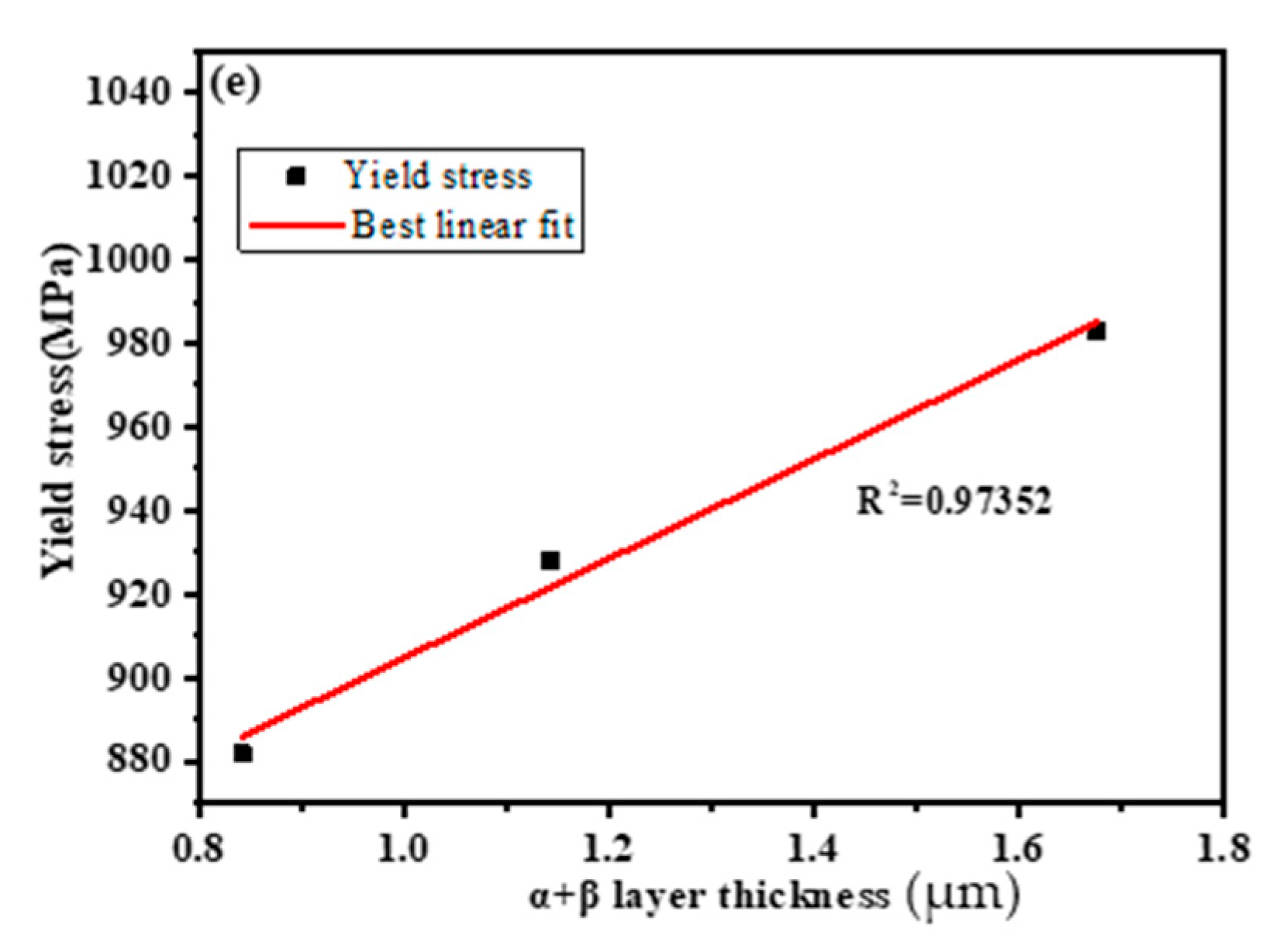

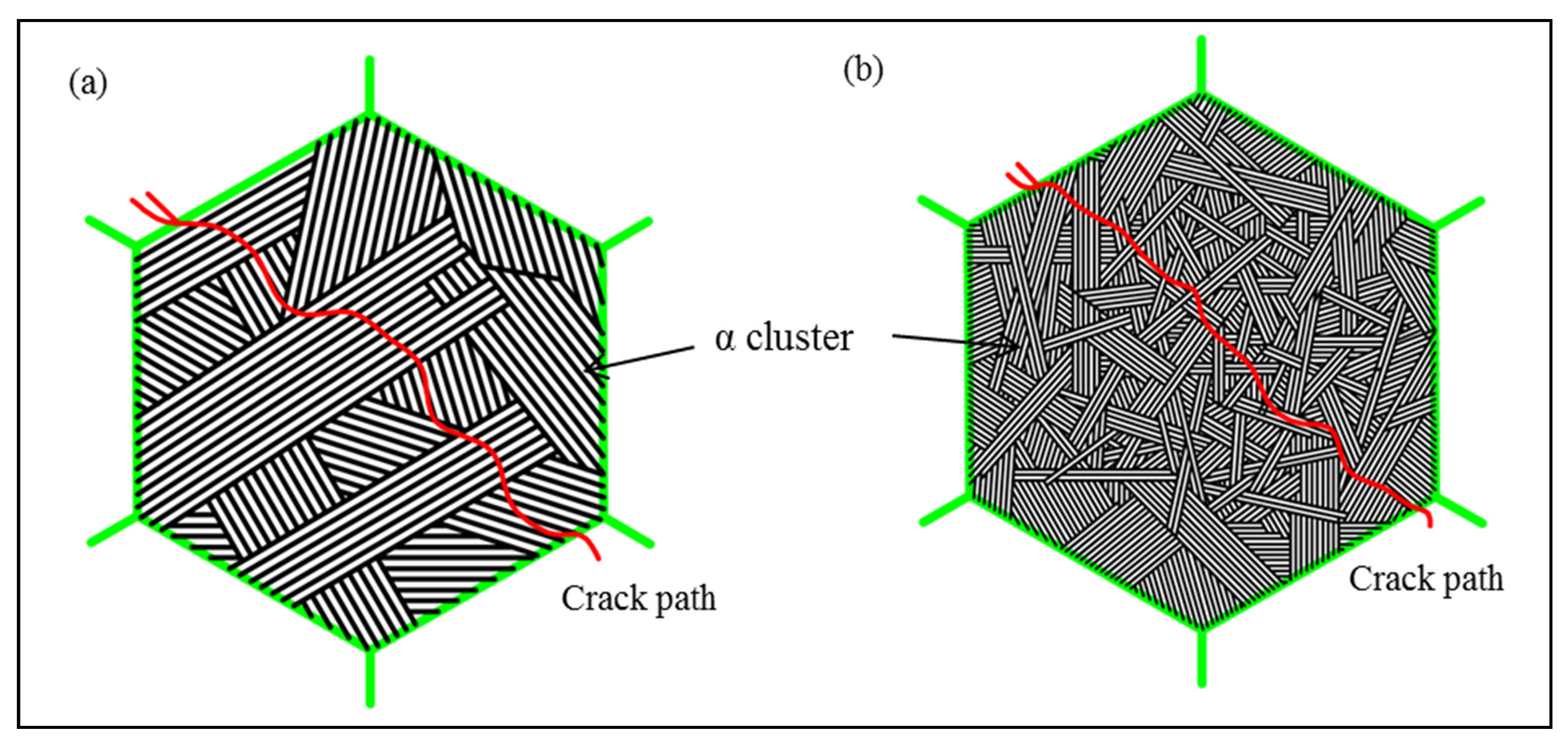
| Cooling Methods | Grain Size of β (dg) | α Platelet Thickness (Tα) | α Colony Thickness (Tc) | Thickness of GB (TGB) | α+β Platelet Thickness (Tα+β) |
|---|---|---|---|---|---|
| FC | 304.79 | 1.2 | 34 | 3 | 1.41 |
| OFC | 250.31 | 0.5 | 9 | 1.5 | 0.77 |
| AC | 242.19 | 0.24 | 5.99 | 0.15 | 0.35 |
| WQ | 238.15 | 0.11 | 5.63 | - | - |
| Cooling Methods | Yield Strength (MPa) | Ultimate Tensile Strength (MPa) | Elongation A (%) | Percentage Reduction in Area Z (%) | Static Toughness U (MJ/m3) |
|---|---|---|---|---|---|
| FC | 881.9 | 986.8 | 10.2 | 14.6 | 100.7 |
| OFC | 928.3 | 1073.9 | 8.8 | 10.2 | 94.5 |
| AC | 982.8 | 1100.4 | 7.1 | 8.3 | 78.1 |
| WQ | 1006.9 | 1114.8 | 6.9 | 8.2 | 76.9 |
Publisher’s Note: MDPI stays neutral with regard to jurisdictional claims in published maps and institutional affiliations. |
© 2022 by the authors. Licensee MDPI, Basel, Switzerland. This article is an open access article distributed under the terms and conditions of the Creative Commons Attribution (CC BY) license (https://creativecommons.org/licenses/by/4.0/).
Share and Cite
Yang, C.; Zhang, S.; Ou, M. In Situ Tensile Deformation and Mechanical Properties of α Platelets TC21 Alloy. Materials 2022, 15, 3869. https://doi.org/10.3390/ma15113869
Yang C, Zhang S, Ou M. In Situ Tensile Deformation and Mechanical Properties of α Platelets TC21 Alloy. Materials. 2022; 15(11):3869. https://doi.org/10.3390/ma15113869
Chicago/Turabian StyleYang, Chunlin, Song Zhang, and Meigui Ou. 2022. "In Situ Tensile Deformation and Mechanical Properties of α Platelets TC21 Alloy" Materials 15, no. 11: 3869. https://doi.org/10.3390/ma15113869
APA StyleYang, C., Zhang, S., & Ou, M. (2022). In Situ Tensile Deformation and Mechanical Properties of α Platelets TC21 Alloy. Materials, 15(11), 3869. https://doi.org/10.3390/ma15113869





